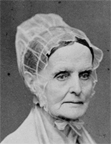

The Beginnings of the Women's Suffrage Movement
The passage of the 15th Amendment after the Civil War ensured voting rights
for all "citizens of the United States" regardless of race or color,
but women's right to vote was neither implicitly nor explicitly guaranteed.
To protest the continued exclusion of women from the electoral process, Susan
B. Anthony intentionally tested the law in 1872 by voting for Ulysses S. Grant
and Republican congressmen. She was arrested a few weeks later and convicted
of illegal voting. The occasion, and the Supreme Court's later refusal to support
her position, helped inspire Anthony in 1875 to draft what was to become the
19th Amendment, also known as the Susan B. Anthony Amendment.
 The
The
 Seneca
Falls, New York convention of July 19-20, 1848 is generally considered the starting
point for the modern women's rights movements in the United States. Among the
principal organizers of the event were Lucretia Mott of Philadelphia and Elizabeth
Cady Stanton. Many of the individuals involved in the convention already were
acquainted through other reform causes, particularly abolition and temperance.
Lucretia Mott's husband, James Mott, presided as chairman; Frederick Douglass
was secretary, and many other men were active participants.
Seneca
Falls, New York convention of July 19-20, 1848 is generally considered the starting
point for the modern women's rights movements in the United States. Among the
principal organizers of the event were Lucretia Mott of Philadelphia and Elizabeth
Cady Stanton. Many of the individuals involved in the convention already were
acquainted through other reform causes, particularly abolition and temperance.
Lucretia Mott's husband, James Mott, presided as chairman; Frederick Douglass
was secretary, and many other men were active participants.
Among the issues considered during the conference were property rights for married women, equal standing for women in the legal system, and improved access to quality education. It was at this conference that Elizabeth Cady Stanton read her famous "Declaration of Sentiments," which enumerated the injustices faced by women under current legal and social conventions and called for a number of reforms. By far, the most radical component of the declaration was the idea that women should demand the right to vote. Stanton and Douglass were the most vocal supporters of this resolution and with their persuasion, the convention adopted all the articles of the declaration, although by a narrow margin. Sixty-eight women and thirty-two men signed the declaration.
 The
Suffrage Cause and Bryn Mawr
The
Suffrage Cause and Bryn Mawr 